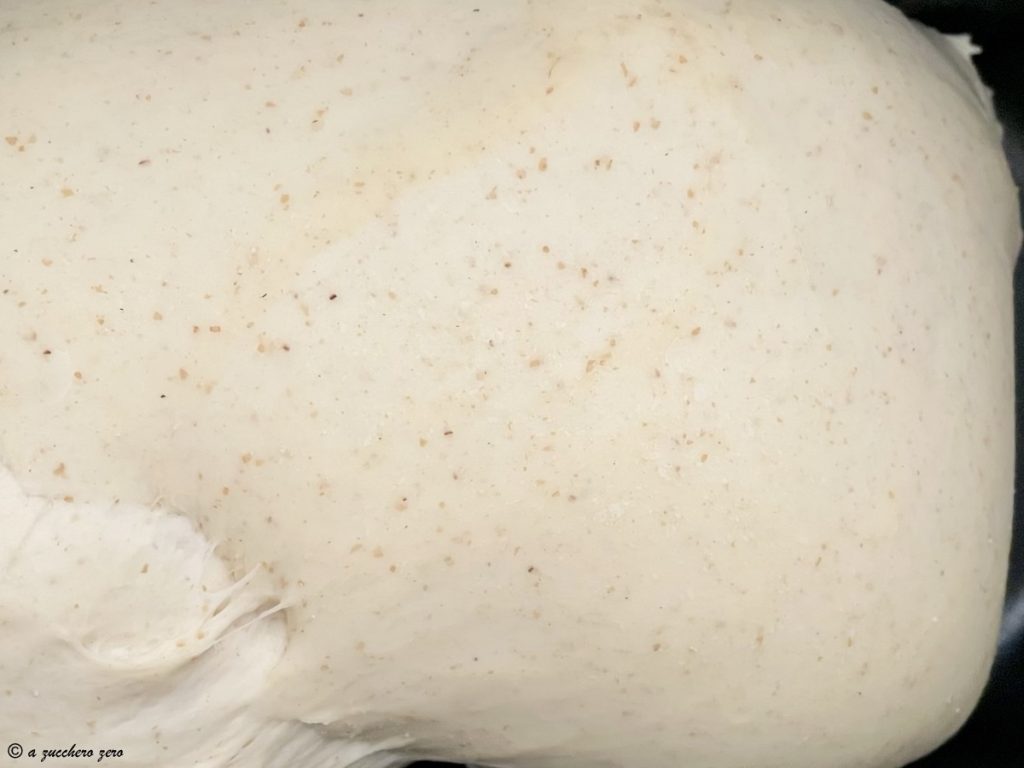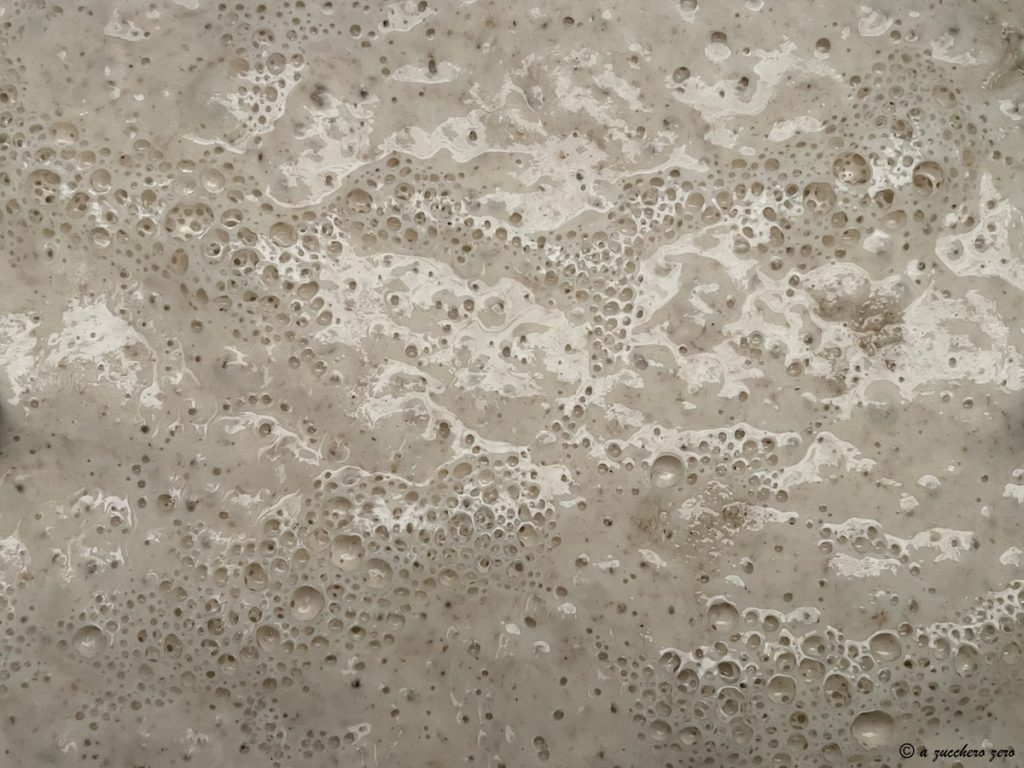The low glycemic index dough is a versatile dough to prepare pizza, focaccia, and rustic fiber-rich dishes:
– low glycemic index pizza;
– low glycemic index focaccia;
– low glycemic index rustic dishes.
I used the low glycemic index mix from Molino Spadoni: based on type 1 flour and resistant starch, rich in fiber and protein, it is a practical ally in case of hyperglycemia, prediabetes, and type 2 diabetes.
No sponsorship.
This content is not part of a collaboration with the brand.
I modified the recipe for sheet pan pizza on the package of the mix by reducing the amount of yeast and applying the poolish method.
Next is the procedure with bread machine and without bread machine.
I swear it’s easier than it seems!

- Rest time: 14 Hours
- Cuisine: Italian
Ingredients
- 1 1/4 cups water
- 1/4 tsp dry yeast (Mastro Fornaio PANEANGELI)
- 300 g low glycemic index flour (Molino Spadoni mix)
- 3 1/3 tbsp water
- 200 g low glycemic index flour (Molino Spadoni mix)
- 1 1/3 tbsp extra virgin olive oil
- 2 tsp salt
- to taste flour (or semolina)
As an alternative to a gram of dry yeast, you can use:
– 3 g of fresh yeast;
– 4 g of dried sourdough yeast.
Suggested Tools
- Bread Machine Imetec Zero Glu or another model
- Glass graduated
- Kitchen Scale digital
- Kitchen Scale spoon
- Measuring Spoons set
- Spatula silicone
- Dough Cutter
- Cutting Board pastry board
Preparation
This recipe can be reproduced with any Bread Machine, stand mixer, or kneading machine as detailed actions and duration of the different phases are indicated; compare the programs before executing the recipe.
Prepare the ingredients for the poolish:
– 1 1/4 cups of room temperature water;
– 1/4 tsp dry yeast;
– 300 g of low glycemic index mix.From the 1 1/4 cups of water, heat a small part: about 3 1/3 tbsp, it should be warm not hot.
Pour it into a small bowl, add and dissolve the yeast.
* from experience, I found it unnecessary to add sugar to activate it.POOLISH WITH BREAD MACHINE
Place the ingredients of the first dough – poolish into the bread pan:
– water;
– water + dissolved yeast;
– low glycemic index mix.
Select the program 13 [bread with little yeast poolish method] and press the START button.
The machine starts kneading for 8 minutes.
With a silicone spatula, bring down the flour remaining on the sides of the container.
Once the kneading phase is over, press the STOP button for a few seconds and turn off the machine [OFF].The poolish must mature for 12 hours, set an alarm!
POOLISH WITHOUT BREAD MACHINE
If you don’t have a bread machine, you can use a stand mixer or a kneading machine or more simply an immersion blender.
Knead for 8 minutes, cover and let it mature.After 12 hours the poolish is mature and appears doubled and full of bubbles.
The appearance varies depending on the flour used.
SECOND DOUGH WITH BREAD MACHINE
Prepare the ingredients for the second dough:
– 3 1/3 tbsp of room temperature water;
– 200 g of low glycemic index mix;
also:
– 1 1/3 tbsp of extra virgin olive oil;
– 2 tsp of salt [adjust the amount according to your taste or dietary needs, you can also skip it].Select the program 18 [kneading and proofing] which includes:
– a kneading phase of 27 minutes;
– three proofing phases of 40 minutes each, total 2 hours;
for a total duration of 2 hours and 27 minutes.Pour over the poolish:
– the water;
– the low glycemic index mix;
and press the START button.
Wait a couple of minutes for the dough to start coming together and add:
– the oil.
Wait a couple of minutes for the dough to incorporate it and add:
– the salt.
With a silicone spatula, bring down the flour remaining on the sides of the container.During the proofing phases do not open the lid to avoid temperature fluctuations; between each phase, the machine emits a signal.
Once the program is finished the machine emits several beeps, remove the bread pan.
The dough is elastic and well-kneaded.

SECOND DOUGH WITHOUT BREAD MACHINE
If you don’t have a bread machine, you can use a stand mixer or a kneading machine for the kneading phase and the oven turned off or use blankets for the proofing phase, extending the times until the dough doubles.Knead for 27 minutes, cover and let it rise until doubled.
Spread a thin and even layer of semolina on the work surface.
Flip the bread pan to extract the dough.
Remember to separate the mixing paddles and carefully remove any dough residue from the bread pan.Turn the dough.
Do not handle it excessively:
– spread a thin and even layer of semolina over the dough;
– with the help of dough cutters, divide the dough into portions.– 200 g portion for thin pizza or focaccia with a crunchy base in a 12×8-inch rectangular pan;
– 400 g portion for thick and soft pizza or focaccia in a 12×8-inch rectangular pan;
– 50-60 g portions for rustic dishes.Modify the portion sizes according to available trays/pans/molds and the desired result: high and soft or thin and crunchy.
Pizza or focaccia in trays/pans/molds
– start by gently spreading the portion from underneath;
– stretch the portion [in a tray/pan/mold or on the work surface]:
start pressing the edges to seal the air inside;
continue pressing towards the center;
always gently!
– stretch the portion with your fingertips to the edge of the mold;
– let it rest in the tray/pan/mold in a turned-off oven for a couple of hours.
After the resting time, proceed with topping and finally baking.
For a detailed step-by-step procedure, you can read the full recipe by clicking the following link: Margherita Pizza.Small rustic dishes like pizza sticks and mini pizzas, calzones, croissants, muffins, panzerotti, Danube
– move the portion to the work surface;
– roll it out with a rolling pin;
– gently stretch it;
– proceed with filling;
– close into the desired shape if it’s stuffed rustic dishes [calzones, croissants, muffins, panzerotti, Danube].
If you want to make small thin and crispy rustic dishes:
– proceed directly to baking.
If you want to make small tall and soft rustic dishes:
– let them rest in a turned-off oven for a couple of hours, then proceed with baking.Temperature and times may vary from oven to oven, depending on thickness and filling.
I set my electric oven as follows:
– maximum temperature 428°F;
– fan mode.Preheat the oven well.
Consider approximately:
– 20-30 minutes of baking for thinly rolled dough;
– 30-40 minutes of baking for thickly rolled dough.Experiment with savory leavened goods:
– bread loaf, rustic loaf, rolls, baguette, ciabatta, loaf;
– sheet pan pizza, Neapolitan, Roman;
– pizza sticks and mini pizzas;
– focaccia and schiacciata;
– leavened flatbread, tigelle, and crescentine;
– naan bread, pita;
– breadsticks and taralli;
– enogastronomic panettone;
– stuffed bread or plumcake;
– stuffed rustic dishes: calzones, croissants, muffins, panzerotti, Danube.Experiment with light sweet leavened goods:
– brioche, croissants, rolls;
– pandoro;
– panbrioche, plumcake;
– panettone;
adding to the dough the sweetener you normally use and/or ingredients like fresh fruit, dried fruit, dark chocolate chips; cinnamon or vanilla and possibly replacing the water with milk or plant-based milk, infusions, or flavored teas with no added sugars.Browse the blog section dedicated to Recipes with the Bread Machine.
Storage, Tips, and Variations
Add seeds [chia, sunflower, flax, poppy, sesame] to the dough to increase fiber and crunchiness.
You can store the dough in the fridge inside a bowl closed with a lid or sealed with plastic wrap, on the bottom shelf right above the vegetable compartment.
Take the dough out of the fridge at least 3 hours before working with it.
You can also take it out the night before to work with it the next morning.
FAQ (Questions and Answers)
What is the low glycemic index mix?
The low glycemic index mix from Molino Spadoni: based on type 1 flour and resistant starch, rich in fiber and protein, it is a practical ally in case of hyperglycemia, prediabetes, and type 2 diabetes.
What is resistant starch
During digestion, digestible starch is broken down into simple sugars causing glycemic spikes.
Resistant starch is not digested and reaches the colon intact, functioning as fiber, hence it does not cause glycemic spikes.
It is not a chemical additive but a type of starch that acts like fiber, helping to reduce the postprandial glycemic response and helping to keep blood sugar more stable.
Can it be consumed by children?
Yes, it can also be consumed by children but it’s best to ask the pediatrician.Where can I find the low glycemic index mix?
In supermarkets – not all unfortunately – or in some pharmacies.
In Sicily, I can’t find it, so I buy it online directly from the manufacturer’s official site: low glycemic index mix from Molino Spadoni.Can I substitute the flours?
In this case, it’s pointless because it is a dough dedicated to those following a specific dietary regimen and a fiber-rich diet.
With experience, you can substitute and vary the flours, considering they have different characteristics.
Whole grain flours absorb a variable amount of water, tend to rise less, and the doughs are less elastic; for a softer result, I recommend mixing them with semi-whole flours like type 2 or type 1 flour.
Naturally, modifying the flours may impact glycemia differently.
To delve into the topic, read the article by clicking the following link: Semolina and flours glycemic index type 2 diabetes.
A valid alternative is this dough based on whole wheat flour and type 2:
– Bread with whole wheat flour and type 2.Long or short proofing?
Today, the schools of thought seem to have split.
In general, the glycemic response is personal and the variables are numerous.
– with glucometer in hand, test your personal response to try to adjust.
To delve into the topic, read the article by clicking the following link: Glycemic index pizza.How many grams of pizza dough per person?
Usually, the pizzeria dough ball weighs 250 g.
Cook and eat according to your dietary plan.

